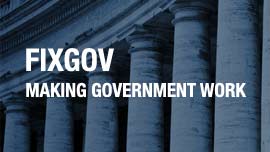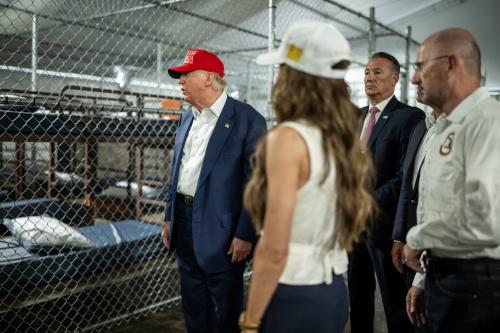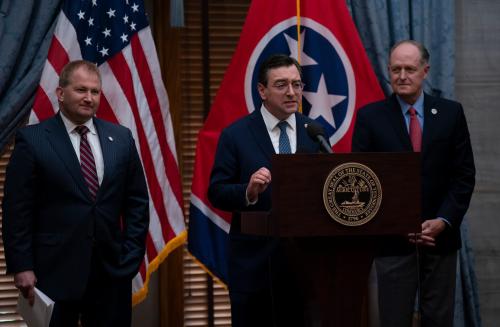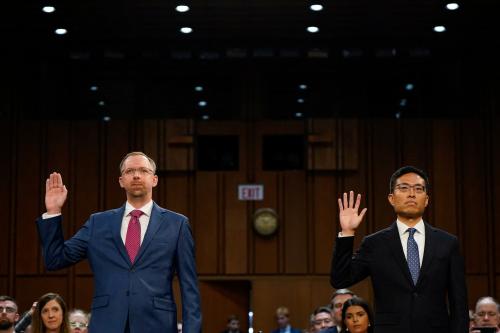Presidents seeking to shift policy through personnel changes may remove most high-level executive branch officials from office pretty much at the chief executive’s discretion (or whim). By contrast, federal district and court of appeals judges, like Supreme Court justices, have essentially life tenure and largely decide for themselves when to leave office, thus creating vacancies that presidents can try to fill. Vacancies created by judges appointed by presidents of the other political party are one key to shifting the ideological orientation of the bench. But replacing judges appointed by presidents’ same-party predecessors can also have an effect, if the new judges differ in judicial outlook from those they replace. In his second term, President Trump may have less leeway than in his first to change either the lower federal courts’ party-of-appointing-president balance or to replace Republican appointees with judges who are more conservative and show more loyalty to him.
As reported in May 2024, Democratic-appointed district judges now constitute a solid majority of all full-time district judges, and not enough of them are likely to leave active status (and thus create vacancies for Trump to fill) to ensure a Republican appointee majority by 2029. (Almost all judges leave active status only when eligible to retire on salary, although most do not do so immediately upon eligibility. A few leave before eligibility—i.e., resign.)
Republican appointees have a slight majority on the courts of appeals, a proportion Trump can increase to the degree that Democratic appointees create vacancies for him to fill. Few of the 29 Democratic appointees who will be eligible to retire by late 2028 are likely do so, however, including the 14 currently eligible—nine of whom were eligible when President Biden took office.
But how many Republican appointees will decide to leave active status during Trump’s second term, creating the chance to replace, say, a middle-of-the-road Reagan or Bush institutionalist with a judge more to Trump’s liking? A clue may lie in the meager number of Republican appointees who decided to leave office after the 2024 election. Judges—including Republican appointees—may be reluctant to have Trump select their successors, given concerns about the types of nominees he has put forward and his public criticism of judges who have ruled against the administration.
Strategic retirements
Elections that change White House party control often see an uptick in judicial vacancies. Many are created by appointees of presidents of the incoming president’s party who deferred leaving because they want their replacements to be selected by a president of the same party as their appointer.
Figure 1 suggests that these “strategic retirements” have been more muted in the early days of Trump’s second term than they were for recent predecessors who defeated candidates of the party controlling the White House. 1
The figure shows—for the roughly nine months from Election Day through July, for presidents since George W. Bush, the number of vacancies that same-party and opposite-party-appointed judges created during those periods, combined with the number of future vacancies that such judges announced. Future vacancies are those that some judges, usually in a pro forma letter to the president, announce by stating their intent to leave active status at some future date. Of the numbers shown in the figures, future vacancy announcements comprise 28% to 62% of the total. (Recissions of future vacancy plans happen but are rare.)
Thus, included in the figures are judges who announced—after Election Day but before Aug. 1—that they were leaving active status immediately, or announced that they would do so at some post-July date. Not included are judges who did so before Election Day, even if the future vacancy they announced actually occurred after Election Day.
The figure—consistent with multivariant analysis that has documented the fact of strategic retirements—suggests strongly that the president who will appoint one’s successor is a factor motivating retirement in the immediate aftermath of an election. It shows that in no instance did more opposite-party-appointed judges vacate office than did same-party appointees. Thirty-six district and circuit judges, for instance, left office or announced they would leave office after George W. Bush’s drawn-out victory; 29 of them were Republican appointees. The same gap shows up for every successor.
Why judges take—or defer—retirement is multifaceted, sometimes reflecting health or other concerns or strategies other than presenting vacancies to the incoming president. And because the numbers above are small, a few more or less retirements could create a different picture. Still, the data are what they are, and they show consistently that same-party appointees have decided, post-election, to leave active status in greater numbers than opposite-party appointees.
Few retirements after Trump’s reelection
Figure 1 shows not only that judges tended to leave active status after the election of a president of the same party that appointed them. It also shows that fewer judges have created or announced vacancies after Trump’s 2024 election than after any presidential election since George W. Bush, including Trump’s first term.
The difference is starkest for court of appeals judges, as shown in Figure 2. After Election Day 2024, just two Republican appointees announced vacancies (both of them future vacancies that incumbents announced in March 2025). These two, combined with four pre-election vacancies, constitute all of Trump 2.0’s appellate vacancies as of early August; two of the six have been filled, and nominees are in place or under discussion for the other four.
These two post-election appellate vacancies compare to more—in some cases, much more—vacancies for all predecessors. During Trump’s first term, seven circuit judges decided to create vacancies in the nine months after the election, compared to two during his second term. After Biden’s election, 15 Democratic appointees decided to create vacancies or announce future vacancies.
Twenty-four Republican appointees (excluding the two future vacancies) are retirement-eligible (and were eligible on Election Day 2024). That they did not rush to the exit on November 4, 2024, is not surprising—some judges disdain retirement. Six of the 24 currently eligible have been so for 15 years. That only two Republican appointees have created vacancies for Trump’s second term, compared with six for George W. Bush and seven for Trump’s first term, may suggest hesitancy about opening opportunities for the current administration.
To the degree such hesitancy is keeping Republican circuit judge appointees from creating vacancies, it is surely operating even more forcefully on Democratic appointees, none of whom created or announced post-election vacancies after the 2024 election, the only such instance on the figure.
Figure 3 shows that retirement-eligible district judges appointed by both parties have been more willing than their circuit counterparts to create vacancies for Trump’s second term, but not by much: The figures are lower than those after the elections of all recent predecessors shown.
Thirty-nine active status Republican-appointed district judges are currently retirement eligible, as are 49 Democratic appointees, but, as noted above, they are unlikely to leave in large numbers.
Why the dearth of post-November 2024 retirements?
No doubt, this sparse-vacancy-creation scene could change abruptly, but the current scene and the possibility that it will persist ask why the greater hesitancy, especially for Republican-appointed circuit judges, to create vacancies for Trump 2.0?
The answer may lie in the behavior of Trump and company. The critiques by some in the conservative establishment and some conservative editorial pages of Emil Bove, Trump’s (since confirmed) court of appeals nominee, formerly his criminal defense lawyer and short-term Justice Department enforcer, may have made judges reluctant to open the door for more such nominations. A Trump nomination adviser’s boast that “this is only the beginning” likely encourages such reluctance.
Many Republican appointees, especially circuit judges, are members of and indeed may owe their nominations to the Federalist Society, which guided Trump 1.0’s judicial selection process but which he is now trashing. He labeled the Society’s Leonard Leo a “sleazebag” who gave him “bad advice” on “numerous” judicial nominations in his first term.
Judges have likely been repelled by Trump’s labelling appointees of both parties who have ruled against him as “lunatics”; by Republican legislators’ efforts to impeach judges who have crossed Trump (including a highly respected Bush appointee); by the physical threats to judges engendered by such attacks; not to mention the frivolous but still dangerous public relations gambit that the Justice Department filed in the guise of a judicial conduct complaint against a district judge who ruled against tactics of the administration’s immigrant removal campaign.
To repeat, the comparatively low 2024-25 retirement rates may be ephemeral. A flood of vacancies may be just around the corner. And why judges take—or defer—retirement is multi-faceted. Still, the low rate of Trump 2.0 retirements seems a clear exception to recent patterns, and administration attacks on judges have been serious enough that Chief Justice John Roberts has taken the rare step of rebuking them. At the least, the developments reported here bear watching.
-
Footnotes
- Note on sources: I gathered senior status, retirement, and resignation data from searches on the Federal Judicial Center’s Biographical Directory of Article III Judges, checked against future vacancy data from the Administrative Office of U.S. Courts’ Archive of Judicial Vacancies, and constructed future vacancy data from that source as well, which includes most of the monthly “Future Vacancies” reports (in changing formats) back to 1980 but lacks reports for the years following the 1980 and the 1992 elections. Corrections to all data reported here gratefully received.
The Brookings Institution is committed to quality, independence, and impact.
We are supported by a diverse array of funders. In line with our values and policies, each Brookings publication represents the sole views of its author(s).







Commentary
Is Trump jeopardizing an opportunity to remake the judiciary?
August 14, 2025